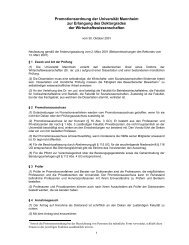The returns to cognitive and non-cognitive abilities in Germany
The returns to cognitive and non-cognitive abilities in Germany
The returns to cognitive and non-cognitive abilities in Germany
You also want an ePaper? Increase the reach of your titles
YUMPU automatically turns print PDFs into web optimized ePapers that Google loves.
<strong>Germany</strong>. <strong>The</strong> yearly data were first collected from about 12,200 r<strong>and</strong>omly selected adult<br />
respondents <strong>in</strong> West <strong>Germany</strong> <strong>in</strong> 1984. After German reunification <strong>in</strong> 1990, the SOEP was<br />
extended by about 4,500 persons from East <strong>Germany</strong>, <strong>and</strong> supplemented by expansion<br />
samples later on. Information on personality traits is provided ma<strong>in</strong>ly <strong>in</strong> 2005, 4 data on<br />
<strong>cognitive</strong> <strong>abilities</strong> is given <strong>in</strong> 2006. In order <strong>to</strong> <strong>in</strong>clude both East <strong>and</strong> West German<br />
<strong>in</strong>dividuals, we restrict our sample <strong>to</strong> the years 1991 <strong>to</strong> 2006. <strong>The</strong> f<strong>in</strong>al longitud<strong>in</strong>al sample<br />
comprises 13,021 person-year observations from 1,580 employed <strong>in</strong>dividuals <strong>in</strong> work<strong>in</strong>g age<br />
(20-60 years) for which there is <strong>in</strong>formation on both personality traits <strong>and</strong> <strong>cognitive</strong><br />
<strong>abilities</strong>. 5<br />
Measures of <strong>cognitive</strong> ability<br />
S<strong>in</strong>ce fully-fletched IQ tests cannot be implemented easily <strong>in</strong> a large-scale panel<br />
survey, two ultra-short tests of <strong>cognitive</strong> ability were developed for the SOEP (Lang, 2005,<br />
Lang et al., 2007), <strong>and</strong> <strong>in</strong>troduced <strong>in</strong> 2006: a symbol correspondence test <strong>and</strong> a word fluency<br />
test. Both tests correspond <strong>to</strong> different modules of the Wechsler Adult Intelligence Scale<br />
(WAIS) which al<strong>to</strong>gether comprises 14 modules, seven on verbal IQ <strong>and</strong> seven on<br />
performance IQ (Groth-Marnat, 1997, Kl<strong>in</strong>e, 1999).<br />
<strong>The</strong> word fluency test as implemented <strong>in</strong> the SOEP is similar <strong>to</strong> a sub-module <strong>in</strong> the<br />
verbal section of the WAIS <strong>and</strong> has been developed after the animal-nam<strong>in</strong>g-task<br />
(L<strong>in</strong>denberger <strong>and</strong> Baltes, 1995): Respondents name as many different animals as possible<br />
with<strong>in</strong> 90 seconds. <strong>The</strong> symbol correspondence test (SCT) was developed after the symboldigit-modalities-test<br />
(Smith, 1995) <strong>and</strong> corresponds <strong>to</strong> a sub-module <strong>in</strong> the <strong>non</strong>-verbal<br />
section of the WAIS. Us<strong>in</strong>g the dist<strong>in</strong>ction of fluid <strong>and</strong> crystallized <strong>in</strong>telligence (Cattell,<br />
1987), the SCT is conceptually related <strong>to</strong> the mechanics of cognition or fluid <strong>in</strong>telligence. It<br />
comprises general <strong>and</strong> largely <strong>in</strong>nate <strong>abilities</strong> <strong>and</strong> refers <strong>to</strong> the performance <strong>and</strong> speed of<br />
12















